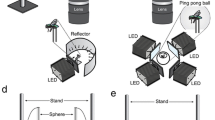Abstract
InDrosophila melanogaster sexual competition experiments, the time course of mating successes is sigmoidal. Following logarithmic transformation, the so-called “Wattiaux equation” changes these curves into straight lines, which can be compared by covariance analysis. This method allows discrimination of the behavior of the two male types in competition and following it during the course of time. From competition experiments between the mutantebony e 11 and the wild-type Canton S, we conclude that the wild-type male flies are really advantaged when rare, at least at a high light intensity. In darkness, even theebony males are advantaged, when rare. The use of less refined indices does not lead to the same conclusion.
Similar content being viewed by others
References
Bryant, E. H., Kence, A., and Kimball, K. T. (1980) A rare-male advantage in the housefly induced by wing clipping, and some general considerations forDrosophila.Genetics 96:975–993.
Ehrman, L. (1965). Direct observation of sexual isolation between allopatric and between sympatric strains of differentDrosophila paulistorum races.Evolution 19:459–464.
Ehrman, L. (1966). Mating success and genotype frequency in Drosophila.Anim. Behav. 14:332–339.
Ehrman, L., and Probber, J. (1978). RareDrosophila males: The mysterious matter of choice.Am. Sci. 66:216–222.
Elens, A. (1957). Importance sélective des différences d'activité entre mâlesebony etsauvage, das les populations artificielles deDrosophila melanogaster.Experientia 13:293.
Elens, A. (1958). Le rôle de l'heterosis dans la compétition entreebony et son allèle normal.Experientia 14:274–276.
Elens, A., and Wattiaux, J. M. (1964). Direct observation of sexual isolation.Dros. Info. Serv. 39:118–119.
Elens, A., Vandenhaute, J., and Delcour, J. (1974). Sexual vigor and sexual isolationiinDrosophila melanogaster.Evolution 27:549–557.
Grossfield, J. (1975). Behavioral mutants ofDrosophila. In King, R. C. (ed.),Handbook of Genetics, Vol. 3, pp. 679–702.
Grossfield, J. (1978). Non-sexual behavior ofDrosophila. In Ashburner, M., and Wright, T. R. F. (eds.),The Genetics and Biology of Drosophila, Vol. 2b, pp. 3–108.
Grossfield, J., and Pak, W. L. (1971). Isolation of autosomal visual mutants inDrosophila melanogaster.Genetics 68:s25.
Jacobs, M. E. (1960). Influence of light on mating ofDrosophila melanogaster.Ecology 41:182–188.
Jacobs, M. E. (1961). The influence of light on gene frequency changes in laboratory populations ofebony and non-ebony Drosophila melanogaster.Genetics 46:1089–1095.
Knoppien, P. (1985). Rare male mating advantage: A review.Biol. Rev. 60:81–117.
Kyriacou, C. P. (1981). The relationship between locomotor activity and sexual behaviour inebony strains ofDrosophila melanogaster.Anim. Behav. 26:1155–1206.
Kyriacou, C. P. (1985). Long-termebony polymorphisss: A comparison of the contributions of behavioral and nonbehavioral fitness characters.Behav. Genet. 55:165–180.
Merrell, D. J. (1950). Measurement of sexual isolation and selective mating.Evolution 4:326–331.
Merrell, D. J. (1983). Frequency-dependent mating?Evolution 37:413–414.
Peterson, J. R., and Merrell, D. J. (1983). Rare male mating disadvantage inDrosophila melanogaster.Evolution 37:1306–1316.
Petit, C. (1951). Le rôle de l'isolement sexual dans l'évolution des populations deDrosophila melanogaster.Bull. Biol. France Belg. 85:392–418.
Petit, C. (1968). Le rôle des valeurs sélectives variables dans le maintien du polymorphisme.Bull. Soc. Zool. France 93:187–207.
Petit, C., and Ehrman, L. (1968). Le rôle de la sélection sexuelle dans l'évolution des populations: l'avantage des types rares dans le groupeWillistoni (genreDrosophila, sousgenreSophophora).Bull. Biol. 102:433–446.
Rendel, J. M. (1951). Mating ofebony, vestigial and wild-typeDrosophila melanogaster in light and dark.Evolution 5:226–230.
Snedecor, G. W. (1956).Statistical Methods, 5th ed., Iowa State University Press, Ames.
Wattiaux, J. M. (1964). Mesure de l'isolement sexuel.Z. Veerbungsl. 95:10–16.
Author information
Authors and Affiliations
Rights and permissions
About this article
Cite this article
Lichtenberger, M., Lechien, J. & Elens, A. Influence of light intensity on rare-male advantage inDrosophila melanogaster . Behav Genet 17, 203–210 (1987). https://doi.org/10.1007/BF01065998
Received:
Accepted:
Issue Date:
DOI: https://doi.org/10.1007/BF01065998




